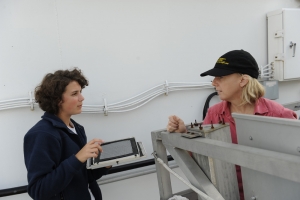PCBs: Dredging Up a Problem
Originally Posted on: May 11th, 2011

Keri Hornbuckle and students Zach Rodenburg and Rachel Yucuis get ready for a research cruise on Lake Michigan in Chicago at Navy Pier.
Polychlorinated biphenyls (PCBs) are known to be one of the most toxic manmade chemicals in our environment— no question there. The question is, how do we get rid of them?
For instance, if scientists report high levels of PCBs in the sludge at the bottom of a canal in an urban area, is it be a good idea to dredge the canal and remove the toxic sludge?
Not so fast, scientists say.
Case in point: the Indiana Harbor and Ship Canal (IHSC) in East Chicago, Ind. For more than a hundred years, toxins generated by heavy industry in East Chicago settled to the bottom of the IHSC, creating a deep layer of thick sludgy mud that is home to everything from heavy metals to polychlorinated biphenyls.
The U.S. Army Corps of Engineers has announced plans to dredge the canal in the next several years for navigational reasons. The plan raises serious questions for scientists. When dredging stirs up a century’s worth of toxins, especially PCBs, what will happen? Will it be better or worse for the people and the environment nearby?
IIHR—Hydroscience & Engineering researchers hope to answer those questions and others through a project within the Iowa Superfund Basic Research Program (ISBRP). ISBRP is a large initiative that brings together projects at several institutions to study the sources, transport, and fate of PCBs, with funding by the National Institutes of Environmental Health Sciences.
PCBs are known to be dangerous to people and the environment, says Keri Hornbuckle, IIHR research engineer and University of Iowa professor of civil and environmental engineering. Hornbuckle is also associate dean for academic programs for the College of Engineering. She is co-lead researcher of an ISBRP project that focuses on the sources of PCBs. Other IIHR researchers involved in ISBRP include Jerry Schnoor (leader, phytoremediation) and Craig Just (leader, community engagement).
“The toxicity is really pretty clear, although not totally understood,” Hornbuckle says. “It’s one of the most toxic chemicals out there, and it was produced in huge magnitude. So the National Institutes of Health are very interested, for good reason.”
Hornbuckle says the canal already presents a tragic situation. “It’s the largest tributary release of PCBs into Lake Michigan, other than the Fox River,” she says. “It’s got every industrial hazardous chemical you could possible imagine … It’s just a mess. It would be good to reduce this source of toxic chemicals to Lake Michigan.”
Researchers are concerned that the plan to dredge the canal could stir up high levels of PCBs buried in the sludge and release them into the air and water, with potentially dangerous effects to people and the environment. Hazardous as these toxins are at the bottom of the canal, Hornbuckle says, it is unclear if removing the sediments will improve the situation.
Hornbuckle’s research has focused on the Great Lakes, although she notes that PCBs have been found worldwide. “We’re really concerned about these chemicals in the Great Lakes, because they accumulate in fish,” she says. Fortunately, she says, interest and funding for Great Lakes research are plentiful. “There is a community of people who demand it,” Hornbuckle says. “[The Great Lakes are] an amazing freshwater resource.”
Hornbuckle and her team of students have been working in the Chicago area, measuring PCBs in the air, water, and soil to find the sources and quantify the levels and movement of the compounds. The team used tandem mass spectrometry to measure PCBs in the canal sediments, an analytical technique that allows researchers to better identify the original sources and future fate. “We have found that the concentration of PCBs in the sediment increases with depth,” Hornbuckle says.
“So if they’re not thinking at all about PCBs, and they simply dredge off a meter in depth, they’re going to expose really high concentrations.”
Andres Martinez, one of Hornbuckle’s postdoctoral scholars, quantified the levels of PCBs being released from sediments in the canal, even before any dredging has occurred. The results demonstrate that even under quiet conditions, sediment in the canal is a significant source of PCBs to the air and water. Other sites with similarly high levels of PCBs have been declared Superfund sites, which by law must undergo clean-up.
The researchers don’t delve into the politics of a tricky situation like the dredging of IHSC, Hornbuckle says. They simply do their work and disseminate their findings, helping others make better informed decisions. In this case, however, one of Hornbuckle’s former graduate students, David Wethington, serves as the Army Corps of Engineers manager for the dredging project. As a student, his work focused on the release of PCBs in Milwaukee. Knowing that someone so well-informed on the subject of PCBs is in charge makes Hornbuckle hopeful.
“He understands the story completely with respect to PCBs,” she says. “It’s a very complicated situation. I could never have prepared him for what he does now. But I hope I’ve helped!”
The work continues to inspire Hornbuckle’s passion for serving the public good, which she in turn passes on to more students every year. It’s no problem motivating the students, Hornbuckle says. “We’re really lucky to get to do this kind of work. It makes it easier to work hard on it, when you think it really matters.”
And, she adds with a smile, “It’s really fun.”



